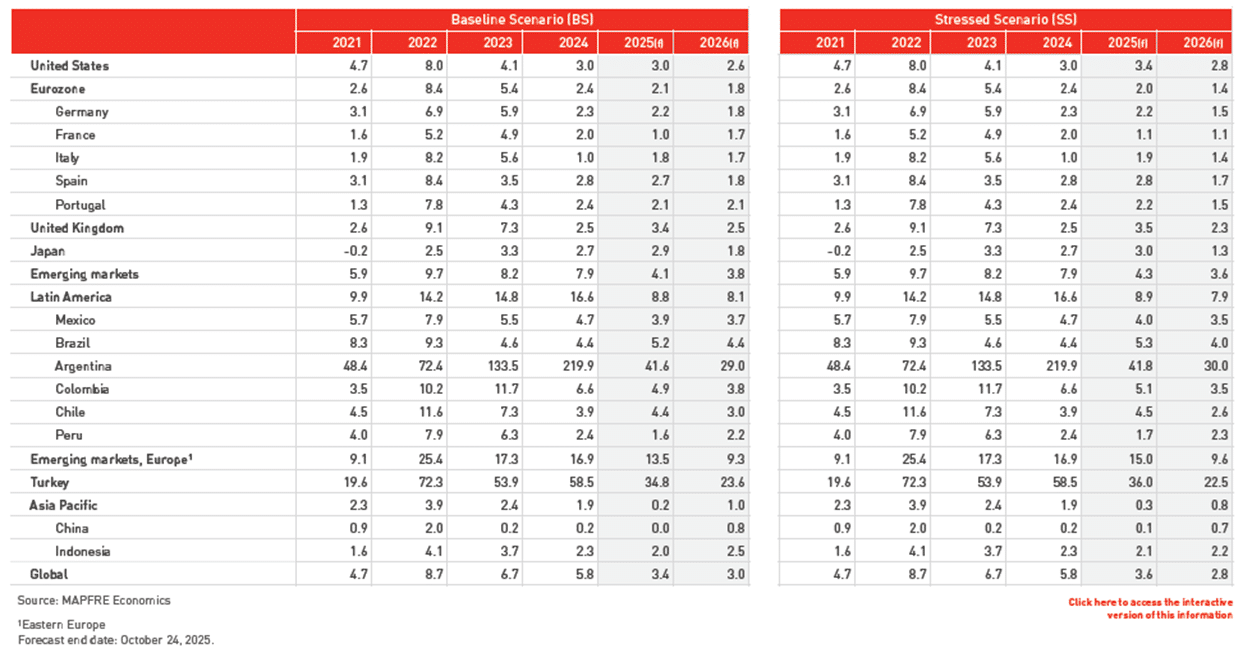Global Economic Outlook (Q4 2025)
Author: MAPFRE Economics
Summary of the conclusions of the:
MAPFRE Economics repot
2025 Economic and Industry Outlook: Fourth-Quarter Forecast Update
Madrid, Fundación MAPFRE, november 2025
Economic outlook
Having passed the halfway point of the year, the global economy has confirmed initial forecasts of a shift towards more balanced growth closer to its potential. Despite persistent challenges, such as geopolitical uncertainty and the effects of recent trade policies, economic activity has shown remarkable resilience. Growth has remained solid, overcoming the risks of a slowdown, thanks to the flexibility and adaptability of economic actors. When it comes to inflation, positive progress has been made in most developed and emerging economies, although there is still some way to go. Central banks have managed to bring inflation within their targets, although in the U.S., slower progress towards the 2% target is expected on account of the impact of new tariffs, which could trigger price adjustments with differing effects globally. In emerging markets, the inflation outlook is also favorable, although more varied. Inflation is expected to remain close to the upper limit of the target ranges of central banks, leading to a cautious approach in monetary policy decisions.
One additional important factor is the excess capacity seen in China, which, in its attempt to maintain the dynamism of its exports, is generating a positive supply shock for the rest of the world (except the U.S.). However, this phenomenon could come with a negative demand shock, weakening local industries and affecting the recovery of domestic consumption. After a first quarter that saw inventory accumulation and precautionary measures by the private sector, the second quarter partially reversed this, although the trend points toward a more evident cyclical slowdown in 2026.
As a result of these dynamics, the global growth forecast has been revised upward for 2025, from 3.0% to 3.1% (3.3% in 2024), while the forecast for 2026 remains virtually unchanged at 3.0%. The inflation outlook remains practically unchanged at 3.4% and 3.0% for 2025 and 2026, respectively. The baseline scenario continues to reflect the central idea of a cyclical slowdown and moderating inflationary pressures, with the impact of tariffs expected to remain limited in 2025 and become more evident the following year. Regarding the risk scenario, geopolitical tensions remain central, combined with negative supply and demand shocks. This is expected to reduce global growth by around 1 percentage point and lead to inflation with asymmetric effects across regions, given the nature of the shock.
In the United States, we continue to expect a slowdown to figures slightly below 2%, driven by consumption that should reflect the weaker employment situation and more moderate future investment growth. It is also worth noting that, although upside risks to inflation have decreased, they still do not provide policymakers with a sufficiently clear path to justify a shift in financial conditions toward expansionary policies.
For the Eurozone, the forecasts include a slight upward revision, although catalysts to overcome structural challenges remain elusive. The manufacturing sector and industrial production remain restricted, while the services sector, although progressing more smoothly, continues to be constricted by weak domestic demand, the incomplete recovery of private sector confidence, and external demand that remains uncertain.
As for Spain, growth projections have once again been revised upward to 2.9% for 2025; this higher growth rate is expected to continue in the coming quarters. We expect slower growth moving forward, although close to its 2% potential thanks to stronger domestic demand, the distribution of NGEU funds, and a lower negative tariff effect than in elsewhere in Europe.
In emerging markets, a favorable inflation and activity outlook is also expected, although the process may vary across countries. This dynamic suggests that caution will be the prevalent, and that, although the interest rate cutting cycle has continued in almost all countries, with some notable exceptions such as Brazil, the direction and pace of easing may still offer different interpretations of how to transition from a restrictive monetary policy to a neutral one.
In Mexico, stagnation is still expected in 2025 (0.5% GDP growth), before improving in 2026 (up to 1.5%). The weakness seen at the start of the year and the uncertainty surrounding the future of trade relations with the United States persist, although the expectations of a gradual recovery moving ahead remain. A closer alignment with U.S. policies is also expected. This could mean that the USMCA review is more likely to succeed and represent an upward catalyst for the economy.
In Brazil, GDP growth has been forecast at 2.2% in 2025 and 1.6% in 2026, with an improved inflation outlook. Despite high interest rates (15%), credit has continued to flow to households and businesses, sustaining a stronger-than-expected economic expansion so far this year and demonstrating a strength that has even called the effectiveness of monetary policy itself into question. In terms of inflation, the improved performance has also meant that price increases remain above the target and that expectations have not dampened as anticipated. However, the effect of monetary policy is eventually expected to have a more visible impact, restricting credit, investment, and ultimately consumption, which would favor lower inflation, anchor expectations, and lay the groundwork for a more accommodative monetary policy in 2026.
Table 1. Baseline and stressed scenarios: gross domestic product
(annual growth, %)
Table 2. Baseline and stressed scenarios: inflation
(%, YoY, average)
The complete analysis of the global economic environment update can be found in the report 2025 Economic and Industry Outlook: Fourth-Quarter Forecast Update, prepared by MAPFRE Economics, which is available at the following link:






